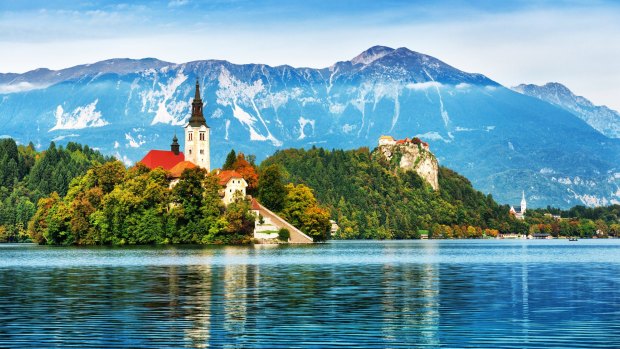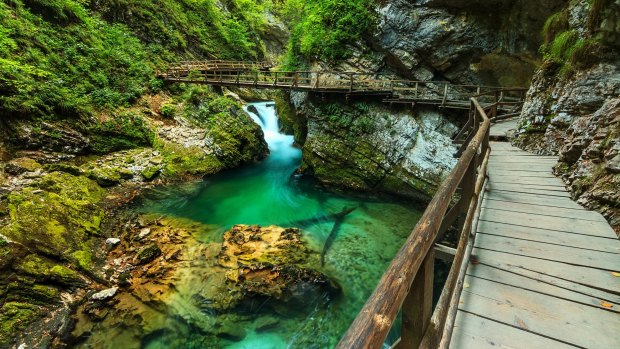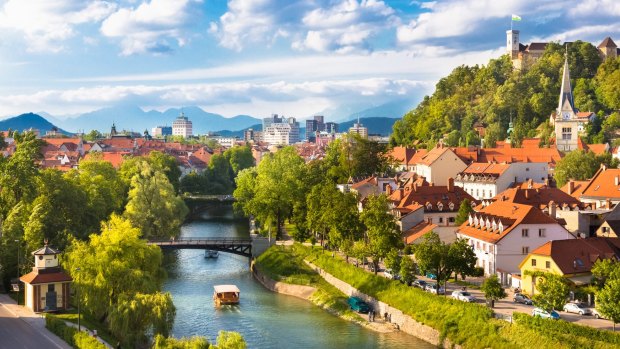This was published 4 years ago
Slovenia: Europe's greenest nation is the little country that could
By Keith Austin

Lake Bled.Credit: iStock
There is much written these days about sustainability, travel and the environment. Not so much How Green Was My Valley as How Green Is My Globe? There's even a Sustainable Destinations Global Top 100 list.
And one country that's been at or near the top of the list since its inception in 2014? Slovenia.
That's Slovenia, cheek-by-jowl with Italy, just north of Croatia. I say this because it often gets confused with Slovakia, with which it shares very little except freakishly similar flags which often get wrongly hoisted at international sports events.

Vintgar Gorge, Bled.Credit: iStock
Making things worse is the fact that the official name of Slovakia is Slovenská Republika while Slovenia is Republika Slovenija. Which might have seemed like a harmless prank at the time but, really?
The world's most famous Slovakian, sorry, Slovenian is America's First Lady, Melania Trump. But, as one local said, don't let that stop you.
Slovenia, it seems is the Little Country That Could. It has a population of just over two million, some two-thirds of its 20,273 square kilometres are forested and, as our guide points out, you can drive from west to east in just three-and-a-half hours, and north to south in two-and-half hours.

Cityscape of the Slovenian capital Ljubljana. Credit: iStock
Only a few weeks previously I had encountered a Slovenian couple while hiking in Greece and had mentioned I was planning to visit. It was, they said, "a lovely little country".
It's a refrain that our guide reiterates several times over the course of our journey. It's a "small country with a big heart", she says, adding "…and good wine, good beer and good food".
And you've got to love people whose idea of breakfast is "espresso, schnapps, and you're good to go".
Our tour - an eight-day, seven-night coach adventure down through Slovenia to Split in Croatia – starts in Venice, where we meet our guide Jerneja Zver. A native Slovenian, Zver explains that her Christian name is pronounced Yerneya but that the best translation for this mixed group of 12 Australians and New Zealanders is 'Jezza'.
We meet Jezza in the Kosher House Hotel in Venice's Cannaregio district - our first port of call on this whistle-stop tour. We're going to be in Slovenia for just two days but with the help of a good guide and a well-thought-out itinerary I'm hoping it's possible to find out if it's worth a second visit.
This is pretty much what Peregrine Adventure's Slovenia to Croatia tour is all about – an action-packed suck-it-and-see journey into the Balkan heartlands.
Slovenia became a full member of the European Union in 2004 and as such there is no hard border between it and Italy. Indeed, the transition between the two is seamless – there are the same craggy outcrops in the sub-alpine landscape, the same 3D jigsaw of terracotta-tiled roofs in deep-rooted villages, each punctuated by narrow church spires like exclamation points. And between them, often, the neat quilt of the vineyards that produce excellent Slovenian wines.
Of all the Balkan states that were born out of the grinding collapse of the former Yugoslavia in 1993, it was Slovenia that came out of the mess with the least lost. Nineteen Slovenians died in the short 10-day war with Yugoslavia while in the other post-Yugoslav conflicts that followed some 133,000 people were killed.
Even today, says Jezza, if you had representatives of Slovenia, Croatia, Serbia, Bosnia and Albania in a room you'd get five different explanations on who started the wars and five different verdicts on who won.
Our first stop is at the Postojna Cave, which Jezza says is one of the most visited cave systems in Europe. It's certainly popular, given the number of vehicles in the carpark. This provokes a moment of despair but after 201 years of tourism (the cave opened in 1819) and more than 39 million visitors so far, they know a bit about moving crowds around in a smoothly professional manner. Before long, we are at the front of the queue for the dinky little yellow trains that plunge into what can only be described as the Jenolan Caves on steroids.
There are some 24 kilometres of paths in the cave but only five kilometres are open to the public. This is plenty, trust me. At the end of the five-minute train ride we disembark in a low-lit cave and follow an English-speaking guide on a weird and wonderful 90-minute tour.
There are enormous stalagmites and stalactites, caverns where the dripping waters have created rock formations like curtains, "rooms" where fragile-looking rock dangles from the ceiling like strands of pasta. And everywhere, the glisten of red, white, pink, brown and red minerals sparkling in clever lighting.
It's a feast for anyone with an imagination, that's for sure. There are frozen courtiers, fairy tale castles, frozen waves, melted candles, undersea corals, ghastly faces, grim monsters … and a chicken. Though you've really got to squint for that last one.
There are also dragons down here. These are the olm; blind, four-legged aquatic salamander (also known as "human fish" because of their pink, fleshy skin colour), which were discovered in 1689 when some of them were washed above ground by heavy rains. Local people believed them to be the offspring of a cave dragon.
There are a few of these fascinating creatures - they can go without food for 12 years and have a lifespan of up to 100 years - in a darkened aquarium near the exit, and more plenty larger, cuddlier versions for sale in the souvenir shops up top. There's even pink "Baby Dragon" ice-cream.
After Postojna Cave we head for Ljubljana, Slovenia's petite (just 300,000 inhabitants) capital, just 50 kilometres away. Jammed full of Baroque, Renaissance, and Art Nouveau architecture, it's one of Europe's smallest capitals and, like the country itself, punches way above its weight in terms of green credentials and sustainability.
It was named European Green Capital in 2016 for its commitment to green ideals and this is evident in the winding streets of the old town, where state-of-the-art recycling bins are everywhere, cars have mostly been banished and clean, green Urban buses ferry tourists around.
We take a guided walking tour, criss-crossing the many pretty bridges across the river and admiring the many public artworks that dot the streets below the medieval castle which has loomed over the town from its eyrie on Castle Hill for hundreds of years.
Our short but sweet excursion into Slovenia is completed with two nights in Bled, not far from the Austrian border. Here we visit the Vogel ski fields in the Triglav National Park above Lake Bohinj and take a traditional rowboat out to the famous church-topped island in the middle of Lake Bled.
It's just a slice of Slovenia but, like the layered custard and cream cake that it's de rigueur to try at Bled's lakeside Park Café, it's certain you'll go back for more.
Keith Austin was a guest of Peregrine Adventures.
Flights are not included in the Peregrine price. All the major airlines fly to Venice's Marco Polo airport.
TOUR
Peregrine Adventures eight-day, seven-night Venice to Split small group (maximum 12 people) coach tour starts in Venice, where the airport arrival transfer is by private water taxi. The tour visits in Postojna Cave, Ljubljana, Lake Bled, Vogel Mountain, Istria, the medieval city of Motovun, Pula, the Plitvice Lakes and Opatija. Tours from A$4240 a person, twin share, and includes seven breakfasts, two lunches, one dinner. Accommodation is in comfortable four-star hotels. Visit peregrineadventures.com
Sign up for the Traveller Deals newsletter
Get exclusive travel deals delivered straight to your inbox. Sign up now.